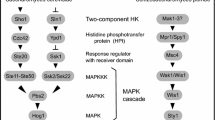Abstract
Brevibacterium epidermis DSM 20659 is a halotolerant Gram-positive bacterium which can synthesize the osmolyte, ectoine, but prefers to take it up from its environment. The present study revealed that B. epidermis is equipped with at least one transport system for ectoine, with a maximal transport velocity of 15.7 ± 4.3 nmol/g CDW·min. The transport requires energy (ATP) and is completely inhibited by the proton uncoupler, CCCP. The ectoine uptake system is constitutively expressed at a basal level of activity and its activity is immediately 10-fold increased by hyper-osmotic stress. Initial uptake rates are not influenced by the intensity of the hyper-osmotic shock but the duration of the increased activity of the uptake system could be directly related to the osmotic strength of the assay solution. Competition assays indicate that betaine, but not proline, is also transported by the ectoine uptake system.
Similar content being viewed by others
References
Cairney J, Booth IR, Higgins CF (1985a) Osmoregulation of gene expression in Salmonella typhimurium: proU encodes an osmotically induced betaine transport system. J Bacteriol 164:1224–1232
Cairney J, Booth IR, Higgins CF (1985b) Salmonella typhimurium proP gene encodes a transport system for the osmoprotectant betaine. J Bacteriol 164:1218–1223
Csonka LN (1989) Physiological and genetic responses of bacteria to osmotic stress. Microbiol Rev 53:121–147
Csonka LN, Hanson AD (1991) Prokaryotic osmoregulation: genetics and physiology. Annu Rev Microbiol 45:569–606
Frings E, Kunte HJ, Galinski EA (1993) Compatible solutes in representatives of the genera Brevibacterium and Corynebacterium: occurrence of tetrahydropyrimidines and glutamine. FEMS Microbiol Lett 109:25–32
Galinski EA (1995) Osmoadaptation in bacteria. Adv Microb Physiol 37:273–327
Glaasker E, Konings WN, Poolman B (1996) Osmotic regulation of intracellular solute pools in Lactobacillus plantarum. J Bacteriol 178:575–582
Glaasker E, Tjan FSB, Ter Steeg PF, Konings WN, Poolman B (1998) Physiological response of Lactobacillus plantarum to salt and nonelectrolyte stress. J Bacteriol 180:4718–4723
Grammann K, Volke A, Kunte HJ (2002) New type of osmoregulated solute transporter identified in halophilic members of the Bacteria domain: TRAP transporter TeaABC mediates uptake of ectoine and hydroxyectoine in Halomonas elongata DSM 2581T. J Bacteriol 184:3078–3085
Kappes RM, Kempf B, Bremer E (1996) Three transport systems for the osmoprotectant glycine betaine operate in Bacillus subtilis: characterization of OpuD. J Bacteriol 178:5071–5079
Onraedt A, Soetaert W, Vandamme E (2005a) Industrial importance of the genus Brevibacterium. Biotechnol Lett 27:527–533
Onraedt A, Walcarius B, Soetaert W, Vandamme E (2005b) Optimisation of ectoine synthesis by Brevibacterium epidermis via fed batch fermentation. Biotechnol Progress 21:1206–1212
Onraedt A, De Muynck C, Walcarius B, Soetaert W, Vandamme E (2004) Ectoine accumulation in Brevibacterium epidermis. Biotechnol Lett 26:1481–1485
Peter H, Weil B, Burkovski A, Krämer R, Morbach S (1998) Corynebacterium glutamicum is equipped with four secondary carriers for compatible solutes: identification, sequencing, and characterization of the proline/ectoine uptake system, ProP, and the ectoine/proline/glycine betaine carrier, EctP. J Bacteriol 180:6005–6012
Poolman B, Glaasker E (1998). Regulation of compatible solute accumulation in bacteria. Mol Microbiol 29:397–407
Ruebenhagen R, Roensch H, Jung H, Kraemer R, Morbach S (2000) Osmosensor and osmoregulator properties of␣the betaine carrier BetP from Corynebacterium glutamicum in proteoliposomes. J Biol Chem 275:735–741
Severin J, Wohlfarth A, Galinski EA (1992) The predominant role of recently discovered tetrahydropyrimidines for the osmoadaptation of halophilic eubacteria. J Gen Microbiol 138:1629–1638
Ventosa A, Nieto JJ, Oren A (1998) Biology of moderately halophilic aerobic bacteria. Microbiol Mol Biol R 62:504–544
Whatmore AM, Reed RH (1990) Determination of turgor pressure in Bacillus subtilis: a possible role for K+ in turgor regulation. J Gen Microbiol 136:2521–2526
Author information
Authors and Affiliations
Corresponding author
Rights and permissions
About this article
Cite this article
Onraedt, A., De Mey, M., Walcarius, B. et al. Transport kinetics of ectoine, an osmolyte produced by Brevibacterium epidermis . Biotechnol Lett 28, 1741–1747 (2006). https://doi.org/10.1007/s10529-006-9149-9
Received:
Accepted:
Published:
Issue Date:
DOI: https://doi.org/10.1007/s10529-006-9149-9




